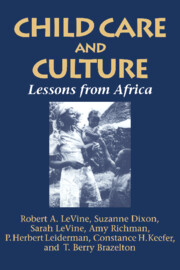Book contents
- Frontmatter
- Contents
- List of tables and figures
- Foreword
- Acknowledgments
- Introduction
- Part I African infancy: Frameworks for understanding
- Part II Parenthood among the Gusii of Kenya
- Part III Infant care and development in a Gusii community
- 6 Infant care: Cultural norms and interpersonal environment
- 7 Survival and health: Priorities for early development
- 8 Communication and social learning during infancy
- 9 Variations in infant interaction: Illustrative cases
- Part IV Interpretations
- Appendix A Fieldwork procedures: Initial phases and planning
- Appendix B Coding categories for spot observations
- Appendix C Blankhart Nutrition Questionnaire
- Appendix D Temperament Assessment Method
- Appendix E Coding categories for narrative observations
- Appendix F Coding categories for face-to-face interaction
- Appendix G Coding categories for maternal teaching task
- Appendix H Supplementary tables
- Notes
- References
- Index
- Plate section
6 - Infant care: Cultural norms and interpersonal environment
from Part III - Infant care and development in a Gusii community
Published online by Cambridge University Press: 11 May 2010
- Frontmatter
- Contents
- List of tables and figures
- Foreword
- Acknowledgments
- Introduction
- Part I African infancy: Frameworks for understanding
- Part II Parenthood among the Gusii of Kenya
- Part III Infant care and development in a Gusii community
- 6 Infant care: Cultural norms and interpersonal environment
- 7 Survival and health: Priorities for early development
- 8 Communication and social learning during infancy
- 9 Variations in infant interaction: Illustrative cases
- Part IV Interpretations
- Appendix A Fieldwork procedures: Initial phases and planning
- Appendix B Coding categories for spot observations
- Appendix C Blankhart Nutrition Questionnaire
- Appendix D Temperament Assessment Method
- Appendix E Coding categories for narrative observations
- Appendix F Coding categories for face-to-face interaction
- Appendix G Coding categories for maternal teaching task
- Appendix H Supplementary tables
- Notes
- References
- Index
- Plate section
Summary
This chapter concerns how Gusii mothers define infant care – their shared assumptions about the tasks and standards involved – and examines the infant's interpersonal environment over the first 30 months of life. Age trends in the infant's social ecology are analyzed in relation to family characteristics and to developmental patterns measured by the Bayley Infant Scales.
THE CULTURAL MODEL OF INFANT CARE
Despite their socioeconomic and religious differences, our sample families in Morongo varied little in how they defined the maternal role and its primary responsibilities. Their model of infant care largely replicated that of the preceding generation, whose norms and practices were recorded in the 1950s. The practices of mothers had been affected by new scarcities as well as new resources. The new resources included blankets, which made it unnecessary to keep the cooking fire going all night, thus reducing the risks of burns; more clothing, keeping children warmer during the rainy season; bottles with nipples, making it unnecessary for child caregivers to force-feed babies from a calabash when the mother was absent; and the use of water from wells instead of streams. In other words, greater access to cash, imported consumer goods, and household improvements had brought a higher level of material welfare that reduced some of the risks to infants observable in the earlier study. Novel scarcities included firewood, still used for cooking but more difficult to obtain in densely inhabited settlements, and children to look after babies, now attending school during the years they formerly spent at home.
- Type
- Chapter
- Information
- Child Care and CultureLessons from Africa, pp. 143 - 168Publisher: Cambridge University PressPrint publication year: 1994



